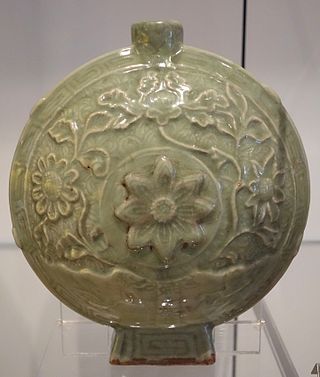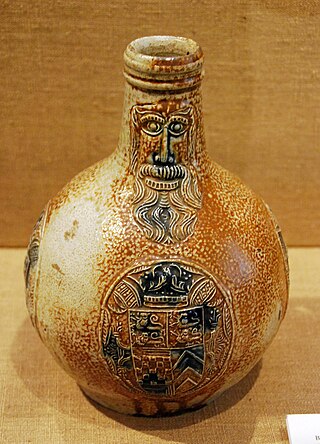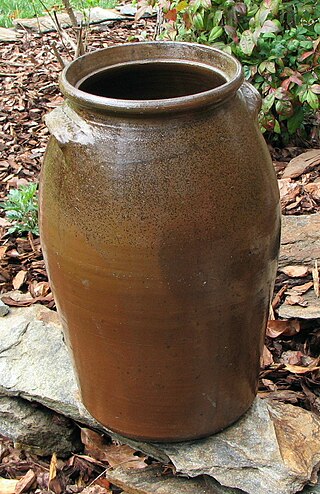Related Research Articles

Pottery is the process and the products of forming vessels and other objects with clay and other raw materials, which are fired at high temperatures to give them a hard and durable form. The place where such wares are made by a potter is also called a pottery. The definition of pottery, used by the ASTM International, is "all fired ceramic wares that contain clay when formed, except technical, structural, and refractory products". End applications include tableware, decorative ware, sanitaryware, and in technology and industry such as electrical insulators and laboratory ware. In art history and archaeology, especially of ancient and prehistoric periods, pottery often means vessels only, and sculpted figurines of the same material are called terracottas.

Longquan celadon (龍泉青瓷) is a type of green-glazed Chinese ceramic, known in the West as celadon or greenware, produced from about 950 to 1550. The kilns were mostly in Lishui prefecture in southwestern Zhejiang Province in the south of China, and the north of Fujian Province. Overall a total of some 500 kilns have been discovered, making the Longquan celadon production area one of the largest historical ceramic producing areas in China. "Longquan-type" is increasingly preferred as a term, in recognition of this diversity, or simply "southern celadon", as there was also a large number of kilns in north China producing Yaozhou ware or other Northern Celadon wares. These are similar in many respects, but with significant differences to Longquan-type celadon, and their production rose and declined somewhat earlier.

Stoneware is a broad term for pottery fired at a relatively high temperature. A modern definition is a vitreous or semi-vitreous ceramic made primarily from stoneware clay or non-refractory fire clay. End applications include tableware, decorative ware such as vases.

Pottery and porcelain, is one of the oldest Japanese crafts and art forms, dating back to the Neolithic period. Kilns have produced earthenware, pottery, stoneware, glazed pottery, glazed stoneware, porcelain, and blue-and-white ware. Japan has an exceptionally long and successful history of ceramic production. Earthenwares were made as early as the Jōmon period, giving Japan one of the oldest ceramic traditions in the world. Japan is further distinguished by the unusual esteem that ceramics hold within its artistic tradition, owing to the enduring popularity of the tea ceremony.

Celadon is a term for pottery denoting both wares glazed in the jade green celadon color, also known as greenware or "green ware", and a type of transparent glaze, often with small cracks, that was first used on greenware, but later used on other porcelains. Celadon originated in China, though the term is purely European, and notable kilns such as the Longquan kiln in Zhejiang province are renowned for their celadon glazes. Celadon production later spread to other parts of East Asia, such as Japan and Korea as well as Southeast Asian countries, such as Thailand. Eventually, European potteries produced some pieces, but it was never a major element there. Finer pieces are in porcelain, but both the color and the glaze can be produced in stoneware and earthenware. Most of the earlier Longquan celadon is on the border of stoneware and porcelain, meeting the Chinese but not the European definitions of porcelain.

Salt-glaze or salt glaze pottery is pottery, usually stoneware, with a glaze of glossy, translucent and slightly orange-peel-like texture which was formed by throwing common salt into the kiln during the higher temperature part of the firing process. Sodium from the salt reacts with silica in the clay body to form a glassy coating of sodium silicate. The glaze may be colourless or may be coloured various shades of brown, blue, or purple.

Chinese ceramics show a continuous development since pre-dynastic times and are one of the most significant forms of Chinese art and ceramics globally. The first pottery was made during the Palaeolithic era. Chinese ceramics range from construction materials such as bricks and tiles, to hand-built pottery vessels fired in bonfires or kilns, to the sophisticated Chinese porcelain wares made for the imperial court and for export. Porcelain was a Chinese invention and is so identified with China that it is still called "china" in everyday English usage.

David Drake, also known as "Dave Pottery" and "Dave the Potter," was an American potter and enslaved African American who lived in Edgefield, South Carolina. Drake lived and worked in Edgefield for almost all his life.

Catawba Valley Pottery describes alkaline glazed stoneware made in the Catawba River Valley of Western North Carolina from the early 19th century, as well as certain contemporary pottery made in the region utilizing traditional methods and forms.

Dorchester Pottery Works is a historic site at 101-105 Victory Road in Dorchester, Massachusetts, a neighborhood of Boston. The Dorchester Pottery Works was founded in 1895 by George Henderson and made stoneware. The Dorchester Pottery Works closed in 1979. The building was designated as a Boston Landmark in 1980 and added to the National Register of Historic Places in 1985.
Colonoware, which is alternately called Colono-Indian Ware, is a type of earthenware created by African Americans along the Atlantic Coast ranging north and south from Delaware to Florida and as far west as Tennessee and Kentucky beginning in the Colonial Era. It was first identified by the British archaeologist Ivor Noël Hume and shortly thereafter published in a book he wrote.
Kamuiyaki ware (カムィヤキ), from Tokunoshima kamïyaki, is grey stoneware produced in Tokunoshima, the Amami Islands, Kagoshima Prefecture, Japan, from the 11th century to the early 14th century, or from the late Heian period to the Kamakura period.
Pottersville is a historic archaeological site located near Edgefield, Edgefield County, South Carolina. It was the site of the Pottersville kiln, which was in existence until the American Civil War when it was abandoned. The kiln was involved in the production and distribution of the alkaline glazed wares. The Pottersville kiln site is now a large mound in a grassy field atop a hill. An adjoining depression may have been the kiln itself with the waste dumps now the mound.
Trapp and Chandler Pottery Site (38GN169) is an historic archaeological site located near Kirksey, Greenwood County, South Carolina. It is the last known intact site of a production center of Edgefield decorated stoneware. The Trapp and Chandler Stoneware pottery was an antebellum pottery factory and began production of Alkaline glazed utilitarian stoneware around 1834. It continued production until the later part of the 19th century.

Reinhardt-Craig House, Kiln and Pottery Shop is a historic home, kiln, and pottery shop located near Vale, Lincoln County, North Carolina. The house, kiln and pottery shop, were built by Harvey Reinhardt between 1933 and 1936. The house is a one-story, rectangular frame building, two bays wide by three bays deep. It has a front gable roof and a shed-roofed, full-width, front porch. The kiln is a traditional, wood-fired, alkaline glaze groundhog cross-draft kiln that includes a firebox, arch, and chimney, all made of brick. It measures 24 feet, 11 inches long by 11 feet, 6 inches wide. The one-story shop is a frame structure with a side-gabled tin roof and wood clapboard siding. Also on the property is a contributing pugmill built in 1949. The pottery was a producer of traditional Catawba Valley Pottery and associated with Burlon Craig.

Ceramic art is art made from ceramic materials, including clay. It may take varied forms, including artistic pottery, including tableware, tiles, figurines and other sculpture. As one of the plastic arts, ceramic art is a visual art. While some ceramics are considered fine art, such as pottery or sculpture, most are considered to be decorative, industrial or applied art objects. Ceramic art can be created by one person or by a group, in a pottery or a ceramic factory with a group designing and manufacturing the artware.
George William Newman Fulton (1834–1894) was a noted potter who worked in Allegheny County, Virginia and in Fincastle, Virginia.
Quillan Lanier Meaders was an American potter best known for face jugs, for which he was regarded as a master of the form.

The Lithgow Valley Colliery and Pottery Site is a heritage-listed former pottery and colliery and now pottery and visitor attraction at Bent Street, Lithgow, City of Lithgow, New South Wales, Australia. It was built from 1876 to 1945. It is also known as Lithgow Pottery and Brickworks. The property is privately owned. It was added to the New South Wales State Heritage Register on 2 April 1999.
Oregon Pottery Company was established in the United States at Buena Vista, Oregon, in 1866. The largest pottery business on the West Coast of the United States at the time, it produced stoneware jars, jugs, and sewer pipe between 1866 and 1897 in Buena Vista and Portland, Oregon.
References
- ↑ Federal and state laws and practices restrict general public access to information regarding the specific location of this resource. In some cases, this is to protect archeological sites from vandalism, while in other cases it is restricted at the request of the owner. See: Knoerl, John; Miller, Diane; Shrimpton, Rebecca H. (1990), Guidelines for Restricting Information about Historic and Prehistoric Resources, National Register Bulletin, National Park Service, U.S. Department of the Interior, OCLC 20706997 .
- 1 2 "National Register Information System". National Register of Historic Places . National Park Service. July 9, 2010.
- 1 2 3 4 Beute Koverman, Jill (2009). "Clay Connections: A Thousand-Mile Journey from South Carolina to Texas". University of South Carolina Scholar Commons. Retrieved 12 December 2023.
- 1 2 Wilson Horne, Catherine (1990). Crossroads of Clay: The Southern Alkaline-Glazed Stoneware Tradition. Columbia, South Carolina: McKissick Museum, University of South Carolina. Retrieved 12 December 2023.
- 1 2 Greer, Georgeanna H. (1977). "Groundhog Kilns-Rectangular American Kilns of the Nineteenth and Early Twentieth Centuries". Northeast Historical Archaeology. 6 (6). Retrieved 12 December 2023.
- ↑ Magnum, Donald G.; Driver, David (September 2017). A Cultural Resources Survey for a 17.5-acre Tract within the Lake Houston Wilderness Park, Montgomery County, Texas (Report). Moore Archaeological Consulting. p. 10. Retrieved 12 December 2023.

